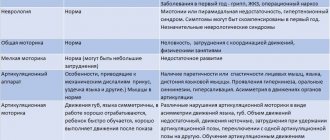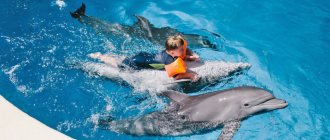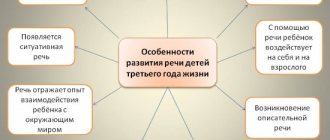Dyslalia in children is distortion or omission of sounds with normal hearing and the absence of pathologies. There are several types of disease:
- Mechanical – caused by pathologies of the organs of the articulatory apparatus.
- Functional – caused by a child’s imitation of an adult’s incorrect speech (tongue-tied, lisping, etc.) or disturbances in the cerebral cortex.
- Monomorphic - a violation of the pronunciation of sounds from one group (S-Z-C or Sh-Zh-Ch).
- Polymorphic – violation of the pronunciation of sounds from different groups (S-R-K-SH).
Causes
The cause of the development of mechanical dyslalia is organic defects in the anatomical structure of the peripheral articulatory apparatus, which includes: jaws, teeth, lips and tongue.
Among the anomalies of the articulation apparatus leading to dyslalia, the most common are:
- short frenulum of the tongue or upper lip;
- macroglossia - massive, tongue;
- microglossia - narrow, small tongue;
- thick, inactive lips;
- malocclusion: deep, cross, open;
- anomalies of the dentition: diastemas, sparsely located or small;
- high narrow or low flat upper palate.
Anatomical defects that cause mechanical dyslalia can be congenital or occur as a result of diseases and injuries of the dental system.
With functional dyslalia, the structure of the articulatory apparatus is not changed, i.e., there is no organic basis for the violation of sound pronunciation.
In this case, the causes of dyslalia are social or biological factors:
- pedagogical neglect;
- "lisping" of adults when talking to children;
- tongue-tied, hasty speech of others;
- bilingualism in the environment;
- minimal brain dysfunction;
- general physical weakness.
Prevalence of the problem
The disease is a common occurrence, most common in the practice of speech therapists.
According to various estimates, the average number of children with such problems in preschool age is 25-30%, in elementary grades – 17-20%, and in older age – 1%. Classes with a speech therapist are also required for adults who have suffered strokes, TBI, or multiple sclerosis. Most often, there are combined disorders of sound pronunciation that prevent further mastery of written speech. At the same time, the vocabulary can be replenished according to age, all cases are used correctly, the structure of syllable formation is not disrupted, speech is developed at a high level.
Symptoms
Four types of sound pronunciation defects in dyslalia: omissions, substitutions, confusion and distortion of sounds.
By skipping a sound we mean its complete loss in one position or another: at the beginning, in the middle or at the end of a word.
Sound replacement is a persistent replacement of one sound with another, also present in the phonetic system of the native language. Sound substitutions are caused by the failure to distinguish phonemes based on subtle articulatory or acoustic features. With dyslalia, sounds can be replaced that differ in place of articulation or method of formation, on the basis of sonority-voicelessness or hardness-softness.
They talk about mixing sounds if two correctly pronounced sounds are constantly confused in the speech stream, that is, their use is either appropriate or inappropriate.
Distortion of sounds is an irregular pronunciation, the use in speech of sounds that are absent in the phonetic system of the Russian language. For example, velar or uvular pronunciation [r], interdental or lateral pronunciation [s] and others. Distortion of sounds is usually found in mechanical dyslalia.
With functional dyslalia, as a rule, the pronunciation of one or more sounds is impaired; in the case of mechanical dyslalia - a group of sounds similar in articulation. Thus, an open anterior bite will contribute to the interdental reproduction of the sounds of anterior lingual articulation [z], [s], [ts], [h], [zh], [sh], [sch], [d], [t], [l ], [n], because the tip of the tongue cannot be held behind the front teeth.
Types of dyslalia
Dyslalia, as a form of speech pathology in children, has various types and forms. The classification depends on the reasons for which the sound pronunciation disorder occurs. Experts distinguish two forms of dyslalia: mechanical and functional.
Mechanical (organic) dyslalia is a form of speech pathology caused by the presence of defects in the structure of the articulatory apparatus.
The causes of functional dyslalia, in contrast to mechanical dyslalia, are associated either with social factors or with reversible neurodynamic disorders in the cerebral cortex.
Functional dyslalia has the following varieties:
- motor dyslalia: this pathology is characterized by imprecise and undifferentiated movements of the tongue and lips, which causes phonetic defects (distortion of sounds);
- sensory dyslalia: with this disorder, auditory differentiation of acoustically similar sounds (hard/soft, dull/voiced, etc.) is difficult, causing the child to mix and replace sounds in oral speech.
In addition, there are cases when experts identify the presence of sensory and motor speech insufficiency; this type of disorder is called “sensorimotor dyslalia.”
The lack of formation of certain signs of sounds and the nature of the speech defect allow us to distinguish the following types of dyslalia:
1. Phonemic dyslalia - the cause of this type of dyslalia is the immaturity of the operations of selecting sounds according to their articulatory characteristics. With this form of dyslalia, the articulatory base may or may not be fully formed. In the first case, the child simply selects the sounds incorrectly; the second option assumes that in the absence of the desired sound, the child replaces it with a simpler phoneme.
2. Phonetic dyslalia - the occurrence of this form of dyslalia is associated with the formation of incorrect articulatory positions. Such a speech disorder manifests itself in the fact that the child pronounces a sound that does not exist in the phonetic system of the language.
Taking into account the number of disrupted sounds, the following types of violations can be distinguished:
- simple dyslalia (monomorphic dyslalia) - characterized by incorrect pronunciation of one sound or several sounds from one group;
- complex dyslalia (or “erased” dyslalia, or polymorphic dyslalia) - characterized by incorrect pronunciation of several sounds from different groups.
Experts also distinguish physiological dyslalia (or age-related), which is characterized by disturbances in sound pronunciation up to 5 years of age, caused by insufficient development of the organs of articulation. This speech disorder goes away on its own after 5 years.
Diagnostics
A speech therapist examines the structure and mobility of the organs of the articulatory apparatus through visual inspection and using special test exercises.
In the process of a speech therapy examination, the nature of the disorder is revealed, namely the absence, replacement, mixing and distortion of sounds in various positions - in isolation, in open, closed or consonant syllables, words at the beginning, middle or end, as well as phrases and texts.
Then the state of phonemic hearing is checked - the ability to auditory differentiate all correlating phonemes.
For mechanical dyslalia, a speech therapist can refer the patient for consultation to an orthodontist or dental surgeon, and for functional dyslalia, to a neurologist.
If hearing loss is suspected, a consultation with an otolaryngologist and a study of the function of the auditory analyzer is carried out.
Dyslalia: classification, forms, types
Neurologists, neuropathologists, reflexotherapists , psychoneurologists, and speech therapists distinguish 2 main types of dyslalia: functional and organic. There are 3 main types of functional dyslalia: articulatory-phonetic, articulatory-phonemic, acoustic-phonemic.
Based on the number of disturbed types, experts distinguish 2 types of dyslalia: monomorphic and polymorphic. With monomorphic dyslalia, the pronunciation of 1 sound or one group of sounds is impaired; with polymorphic dyslalia, the pronunciation of two or more sounds or groups of sounds is impaired.
With dyslalia, one or another sound may not be pronounced, one sound may be replaced by another, pronounced in isolation, but absent or distorted in independent speech.
Correction
Correction of dyslalia is usually divided into three stages:
- Preparatory stage. In case of mechanical dyslalia, at this stage it is necessary to eliminate anatomical defects in the speech-forming apparatus: orthodontic treatment, plastic surgery of the frenulum. For functional motor dyslalia, speech therapy massage and articulatory gymnastics are indicated. Treatment of sensory dyslalia begins with the development of phonemic processes.
- Formation of primary pronunciation skills. It includes the production of isolated sounds, their automation in words, syllables, sentences, as well as the differentiation of sounds.
- Formation of communication skills. At this stage, it is necessary to develop in the child the skills to correctly use the given sounds in any communication situations.
Speech therapy classes for the correction of dyslalia should be conducted regularly, at least three times a week. It is important that speech therapist tasks and articulation gymnastics are also performed at home.
Dyslalia: definition, causes, work plan. “The child is burring and does not speak the sounds R, L, S, Sh...”
At the very beginning of work, the doctor draws up a plan for solving the following tasks:
— The speech therapist must establish a friendly relationship with the patient, win him over and adapt to the environment of the speech therapy room, arouse his interest in the classes; — Formation of the child’s awareness of activities; — Develop memory and attention; — Teach phoneme recognition; — Form motor speech skills.
The preparatory stage is divided into the following areas:
— Formation of phonemic processes; — Formation of articulatory motor skills; — Formation of fine motor skills of the hands; - Strengthen reference sounds.
Development of phonemic processes. Before proceeding with the development of phonemic processes, it is necessary to form in the patient an idea of the sound that he needs to deliver. It is necessary to teach the child to distinguish specific sounds from similar sounds.
The features of this task are: 1. First, you need to form the child’s conscious involvement in the treatment process; 2. The development of phoneme perception should be carried out first on the material of words. 3. Help the patient distinguish between heard sounds in speech
Considering that the articulatory structure of a certain sound is not initially formed, it is impossible to work on its difference. However, this type of treatment is necessary at the preparatory stage, so it should be carried out using the example of intact pairs of sounds in words. To learn to distinguish a certain sound from its substitute, it is necessary to pronounce it in perception. It is worth prohibiting the reproduction of speech material with a defective sound until the phoneme is delivered. To do this, it is necessary to study the sound composition of words. For this purpose, patients are given tasks to determine the place of a sound in a word. It is important to consider that such constructions should be carried out only on the material of vowels and simple consonants.
From this it follows that the development of phonemic processes at the preparatory stage is carried out in the following directions: 1. Perception - discrimination and perception of sounds by ear; 2. Pronunciation – practicing speech using preserved sounds.
Development of articulatory motor skills
Since, with any form of dyslalia, the pronunciation of sounds is impaired, it is necessary to establish the correct articulatory structure or form the missing articulatory movements. There are no gross motor disorders, which means muscle tone is fine. However, the patient has not formed only individual voluntary articulatory movements. In this case, the development of motor skills should be voluntary, conscious and aimed at the development of new speech patterns. For this purpose, the speech therapist forms the missing articulatory patterns according to visual imitation. In front of a mirror, the child is shown the necessary posture of the organs of articulation. If difficulties arise, the speech therapist helps the patient using his fingers or a spatula. If the child still cannot physically imitate the doctor, then articulation gymnastics is performed.
The goals of articulatory gymnastics are: 1. Formation of kinesthetic sensations from the movements of the speech apparatus; 2. Creating an articulatory pose.
Articulatory gymnastics develops and shapes the mobility of the articulatory organs. For this, speech therapists use in their practice: exercises for the lips, tongue, lower jaw, soft palate, and so on. Speech therapy articulation gymnastics consists of static and dynamic exercises.
Static exercises develop the ability to create and maintain the desired articulatory position. And dynamic training develops operational switchability, dynamism and smoothness of movements.
When working with the tongue, the “Needle” exercise is used, for which you must follow the instructions: - Open your mouth slightly - Stick your tongue forward - Hold, counting to yourself to 10
Another dynamic exercise is the “Clock” exercise: the tongue should alternately touch the left and right corners of the mouth, counting one or two. The above activities must be performed on command so that they are conscious.
While working with gymnastics, the speech therapist is required to develop the following qualities: 1. Precision in performing the exercises. The quality is determined by the location of the shape of the speech organ. 2. Structured and smooth movements. The exercise should be performed without unnecessary movements and jolts 3. Maintain the pace. Initially, the task must be performed slowly, and then faster. The patient must learn to independently change the tempo of articulatory movements 4. Consolidate the result. The articulatory pose must be maintained for up to 15 seconds 5. Switchability. The change of movements should occur smoothly, but quickly 6. Movements of organs are symmetrical to the right and left sides
When conducting articulatory gymnastics, the following requirements must be observed: 1. Conduct classes with static and dynamic exercises 2. Classes with a combination of tongue and lips 3. The duration of classes should be short so as not to overtire the child 4. It is necessary to develop self-analysis of kinesthetic sensations with sound 5. Gymnastics should be carried out in a playful way 6. Tasks are performed in a sitting position so that the arms and muscles are relaxed 7. Articulation exercises are gradually made more difficult 8. Classes are conducted in front of a mirror
To determine the content of articulation exercises, it is necessary: 1. Parse the generalized sound into movements 2. Determine incorrect pronunciation 3. Form the desired structure through articulation exercises 4. Work with certain parts of the structure using differentiated articulatory gymnastics. Once individual movements have been worked out, they need to be combined. Next, the exercises include an air stream and working on the vocal folds.
In order to eliminate labial-dental pronunciation, use the following exercises for the tongue: 1. Hold the tongue on the lower lip and hold it for 5 seconds 2. Hug the upper lip with the tongue and hold this position 3. Hug the upper lip with the tongue and close the mouth with the tongue in the form of a “spoon” - close your mouth after this
Exercises for the lips: 1. Expose the lower jaw, lowering the lower lip and hold for 5 seconds 2. Hold the lips with a tube for 5 seconds 3. Make the lips a tube, and then smile. Repeat, alternating the position of your lips for a count of one or two.
As soon as the exercises are completed clearly and correctly, the speech therapist invites the child to make two articulation positions simultaneously and breathe or blow to hear the sound “sh”. If the sound still does not sound clear, work on clarifying it continues with the help of additional articulatory positions.
Next, it is important to form an air stream, for this follow the instructions: 1. Inflate your cheeks and hold the air in them 2. Alternately transfer air from one cheek to another 3. Retract your cheeks
Development of fine motor skills of the hands Usually, with dyslalia, the movements of the hands are impaired. To develop the functions of the hands, mosaics, lacing, fastening buttons, drawing, working with scissors, plasticine, working with small objects, and so on are used in practice.
Practicing reference sounds With dyslalia, vowels and consonants are preserved. If the articulation of consonants and vowels is incorrect, then the necessary sounds are set, and then they are used with patterns of complex sounds. By the way, the sounds “f” and “v” are the reference sounds for whistling and hissing phonemes. The shape of their formation is slotted; their reproduction requires a long, definitely directed air stream. The sounds “f” and “v” are among the easiest to pronounce. If the patient masters labial-dental sounds, then the correct pronunciation of whistling and hissing sounds automatically develops. If these phonemes are inaccurate, then the reason for this is weak articulatory muscles of the lips. In this case, it is necessary to form an air stream, which is also necessary for reproducing slot sounds. If a child cannot hold the tip of the tongue behind the upper teeth and pronounces them between the teeth, then when pronouncing the phonemes “r”, “l” or hissing sounds, the tongue will also be between the teeth. If the tip of the patient's tongue cannot be held between the teeth, whistling sounds will be suffered. By working on the articulation of the “t” sound, the correct structure of the “s” sound is formed. And if you connect the front part of the back of the tongue with the upper incisors, you get the sound “ts”. When working with the sound “s”, the doctor achieves a targeted air stream that moves along the middle of the tongue. Accordingly, when practicing reference sounds, the motor and auditory parts of speech develop. Thanks to this, the analysis and synthesis of word combinations is formed for the rapid automation of disturbed sound.
Who to contact
The main condition for the success of diagnosing and eliminating a speech disorder is the coordinated work of a neurologist and a speech therapist-defectologist. The doctor and speech therapist evaluate the specifics of fine motor skills and the functionality of the finger joints. If the cause of the disorder is a neurological pathology, then when planning correctional classes, the defectologist relies on the conclusion of a neurologist.
In order for the diagnosis to be made correctly, it is important to reassure the child. Because nervousness, crying or fear increase muscle tone, which distorts information about the baby’s speech and motor abilities.
Characteristics of the defect
When diagnosing acoustic-phonemic dyslalia, three forms of phoneme pronunciation disorders are distinguished:
- Sound skipping. For example, “house - om”. The baby skips the first syllable because he doesn’t hear it. This form of disorder is rare.
- Replacing phonemes. At the same time, the child’s articulation is correct, all sounds are pronounced clearly. An example of such a substitution: “rice” - “fox”, “bil” - “drank”. In this case, the replacement can be selective, when the child replaces only sibilant (zh - sh) or sonorant (l - r) consonants. Such a violation indicates an incorrect formation of the phonetic-phonemic system.
- Confusion in sounds. The child distinguishes phonemes, however, when pronouncing them, he replaces one with another, choosing from phonetic groups that are similar in articulation.
Children with dyslalia have difficulty communicating. The baby pronounces words incorrectly, so it is difficult for others to understand him, and in addition, he is not always able to correctly recognize someone else's spoken speech.
In written speech, the defect does not always appear. Children can write dictations without errors, but allow them in creative (essays, presentations) works.
Causes of the disorder and mechanism of development
Provoke the appearance of a defect:
- Physiologically incorrect formation of the maxillofacial system, mouth and nasopharynx. Anatomical abnormalities lead to incorrect articulation of entire groups of sounds. Children with an anterior bite have problems pronouncing sibilant consonants because it is difficult to hold the tongue behind the teeth.
- Despite normal physiological hearing indicators, children with acoustic-phonemic dyslalia have not developed a sensory understanding of oral speech. There is no recognition function, comparison of common and different features of phonemes, as a result of which the child perceives words incorrectly.
The main reason for such a speech disorder is the immaturity of phonemic hearing.
The child does not distinguish between sounds, so he replaces one with the other when pronouncing. Usually, the sounds of one acoustic group are replaced: sonorant, whistling, hissing, voiced or voiceless.
Dyslalia, correction of dyslalia, treatment of dyslalia in Saratov, Russia
Sarklinik provides treatment for dyslalia in Saratov , treatment for dyslalia in Russia in children, boys, girls, treatment for tongue-tiedness. Complex treatment allows you to normalize and improve the child’s speech, sounds are staged, special procedures are carried out. In the prevention of dyslalia, proper speech education in young children is important, when it develops most intensively. The younger the preschool child, the faster dyslalia is treated.







